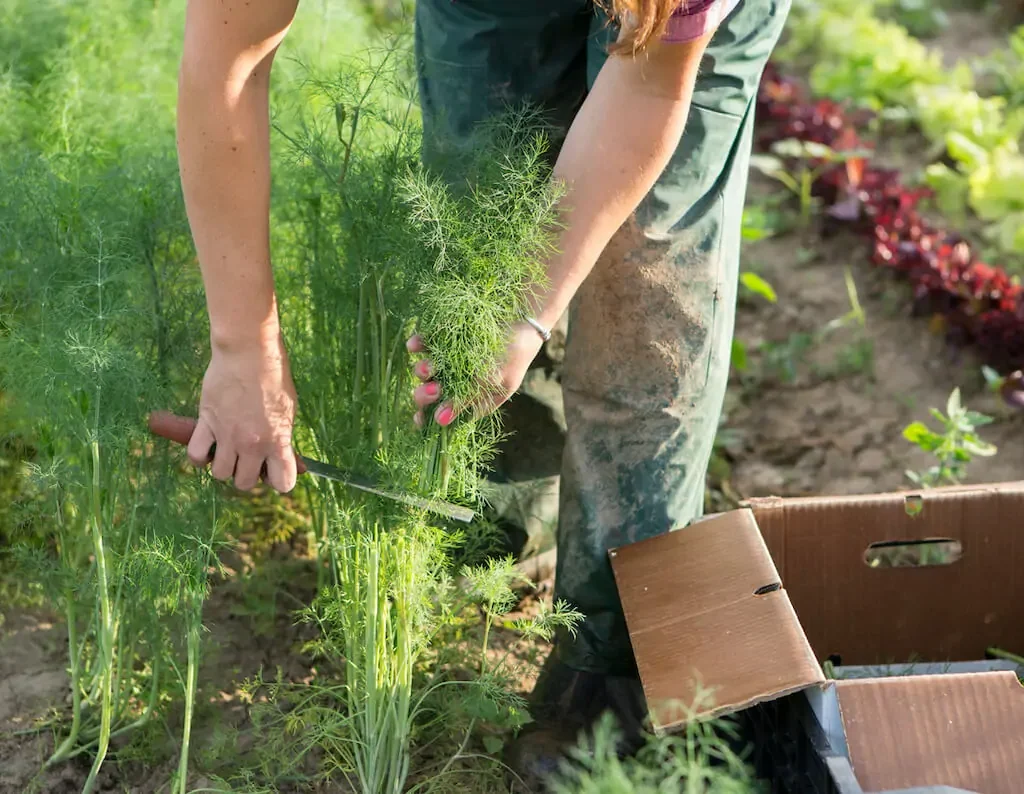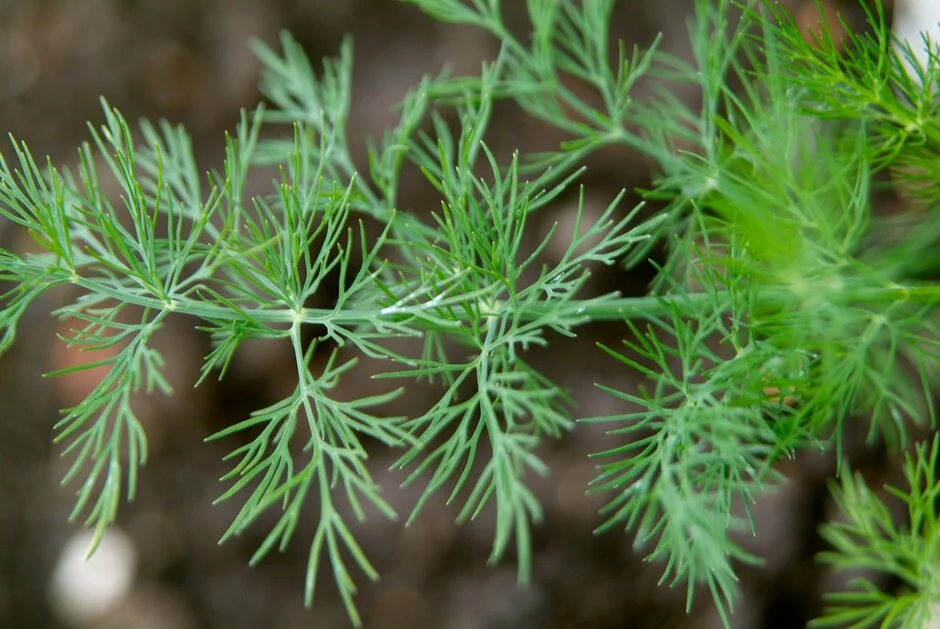Dill (Anethum graveolens) is a fragrant annual herb cherished for its feathery leaves, distinct aroma, and versatile uses in the kitchen and beyond. Whether you’re seasoning pickles, flavoring fish dishes, or brewing herbal tea, dill is a must-have in the herb garden. Its quick growth, minimal care requirements, and medicinal properties make it a favorite for both beginner and experienced gardeners.
This article serves as a comprehensive dill growing guide, covering everything from planting and care to harvesting and its many culinary and herbal uses.
Why Grow Dill?

Dill is more than just a cooking herb. Here’s why it deserves a spot in your home garden:
- Easy to Grow – Thrives in many climates with minimal effort.
- Fast Growing – Ready for harvest within 6–8 weeks.
- Dual Purpose – Both leaves (dill weed) and seeds are edible.
- Pollinator Friendly – Dill flowers attract beneficial insects like bees and ladybugs.
- Medicinal Benefits – Known for its digestive and anti-inflammatory properties.
Step 1: Choosing the Right Dill Variety
Several dill varieties exist, each with unique qualities:
- Bouquet Dill – Fast-growing, excellent for pickling; popular in home gardens.
- Mammoth Dill – Tall variety (up to 5 feet), perfect for harvesting seeds.
- Fernleaf Dill – Compact, slower to bolt, suitable for container growing.
- Dukat Dill – Rich in essential oils, ideal for strong flavor.
- Vierling Dill – Decorative and long-lasting foliage, often grown for ornamental and culinary purposes.
For beginners, Bouquet or Fernleaf dill is highly recommended.
Step 2: Soil and Location Preparation

Dill thrives in full sunlight and prefers:
- Soil Type: Well-drained, slightly sandy loam.
- Soil pH: Neutral to slightly acidic (5.5–7.0).
- Preparation: Enrich the soil with compost or organic matter for strong growth.
Tip: Avoid waterlogged soil, which leads to root rot.
Step 3: Planting Dill

Dill is best grown from seeds rather than transplants since it doesn’t like being disturbed once established.
Direct Sowing Outdoors
- Plant seeds ¼ inch deep in prepared soil.
- Space seeds 12–18 inches apart in rows.
- Thin seedlings once they reach 2–3 inches tall.
Indoor Sowing
- Start seeds in biodegradable pots 2–3 weeks before the last frost.
- Transplant seedlings carefully to avoid root disturbance.
Container Growing
- Use a container at least 12 inches deep to support the long taproot.
- Choose compact varieties like Fernleaf dill for best results.
Step 4: Watering and Fertilizing

- Watering: Dill requires consistent moisture, especially during hot weather. Water deeply 1–2 times per week. Avoid overwatering.
- Fertilizing: Dill doesn’t need heavy feeding. A light application of compost or a balanced fertilizer (10-10-10) every 4–6 weeks is sufficient. Too much fertilizer can reduce flavor intensity.
Step 5: Caring for Dill Plants
- Thinning: Space plants 12 inches apart for airflow and strong growth.
- Mulching: Apply straw or leaves around plants to conserve moisture.
- Support: Tall dill varieties may need staking to prevent lodging in windy areas.
- Weeding: Keep the area weed-free to prevent competition for nutrients.
Step 6: Dealing with Pests and Diseases
While dill is generally low-maintenance, a few issues can occur:
- Aphids – Use neem oil or insecticidal soap.
- Caterpillars (Swallowtail Butterfly Larvae) – Though they feed on dill, many gardeners leave them as they transform into pollinators.
- Powdery Mildew – Prevent by ensuring good airflow and avoiding overhead watering.
- Root Rot – Caused by poor drainage; improve soil texture.
Companion Planting Tip: Dill grows well with cucumbers, onions, and lettuce but should be kept away from carrots to avoid cross-pollination.
Step 7: Harvesting Dill

Both dill leaves and seeds are edible, but the timing of harvest is crucial:
Harvesting Leaves (Dill Weed)
- Begin harvesting leaves when the plant is 6–8 inches tall.
- Cut leaves early in the morning for maximum flavor.
- Regular harvesting encourages more growth.
Harvesting Seeds
- Wait until dill flowers form umbels and turn brown.
- Cut the seed heads and place them in a paper bag to dry.
- Store seeds in airtight containers for culinary or planting purposes.
Step 8: Preserving Dill
To enjoy dill year-round, preservation is key:
- Freezing: Chop fresh dill leaves and freeze in ice cube trays with water.
- Drying: Hang stems upside down in a dark, well-ventilated area.
- Pickling: Fresh dill heads are essential for flavoring homemade pickles.
Culinary Uses of Dill
Dill is a kitchen superstar with multiple applications:
- Fresh Leaves (Dill Weed):
- Sprinkle over fish, poultry, and potato dishes.
- Add to yogurt, sour cream, or salad dressings.
- Use as garnish for soups and stews.
- Dill Seeds:
- Popular in pickling cucumbers.
- Add to breads, stews, and bean dishes.
- Brew into soothing digestive tea.
- Dill Flowers:
- Used in pickling and as edible garnishes.
Herbal and Medicinal Uses of Dill
Dill has been valued in traditional medicine for centuries:
- Digestive Aid: Dill tea helps relieve bloating, gas, and indigestion.
- Antimicrobial Properties: Seeds contain compounds that fight bacteria.
- Calming Effects: Dill has mild sedative qualities, promoting relaxation.
- Rich in Nutrients: High in vitamins A and C, calcium, and iron.
- Lactation Support: Traditionally used to promote milk production in nursing mothers.
Companion Uses in the Garden
Beyond its culinary and medicinal value, dill serves important roles in the garden:
- Pollinator Magnet: Attracts bees, ladybugs, and hoverflies.
- Beneficial Insects: Provides habitat for predatory insects that reduce pests.
- Trap Crop: Can lure pests like aphids away from other crops.
Common Mistakes to Avoid
- Transplanting Mature Plants: Dill doesn’t like being moved once established.
- Overcrowding Plants: Reduces airflow and encourages diseases.
- Too Much Fertilizer: Leads to weak flavor in leaves.
- Ignoring Flowering: Once dill bolts, leaf production slows. Harvest before full flowering if you want more foliage.
Growing Dill Indoors
For year-round access to fresh dill:
- Use a sunny windowsill with at least 6 hours of light.
- Grow in deep pots to accommodate the taproot.
- Use grow lights if natural light is insufficient.
Compact varieties like Fernleaf dill perform best indoors.
Conclusion
Dill is a versatile, fast-growing herb that rewards gardeners with both culinary delight and herbal benefits. From its delicate leaves to its flavorful seeds, every part of the dill plant has a purpose—whether it’s enhancing meals, soothing digestive troubles, or supporting pollinators in your garden. With just a bit of care in soil preparation, watering, and harvesting, you can enjoy a steady supply of dill at home.
Whether you’re growing dill for cooking, herbal remedies, or ornamental value, this feathery herb is one of the most rewarding plants to cultivate. Simple, fragrant, and multipurpose, dill truly deserves a permanent spot in every home garden.




Leave A Comment